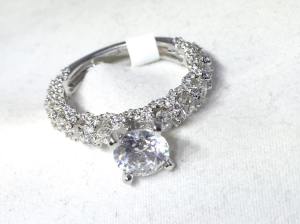Give her jewelry from Gold Galore Diamond Center. Visit us today in the Forest Acres Plaza! 727-856-5084
We Buy Diamonds!
Diamond Education: What is a diamond?
• A diamond is a mineral. In mineralogy, the word diamond comes from the ancient Greek word “adamas” meaning unbreakable. The diamond is the only gem composed of a single element; Carbon (chemical element C). Diamonds are the hardest natural substance on Earth.
• Most Natural diamonds are formed at high temperature and pressures at depths of 140 to 190 kilometers (87-120 mi) in the Earth’s mantle. Diamonds are brought close to the Earth’s surface through deep volcanic eruptions by magma. A diamond’s value is often affected by the rarity of one or more of the FOUR C’s.
Did You Know:
• Although the first recorded history of the diamond dates back some 3000 years ago to India, one of the first most acclaimed discoveries was in Cape Town, South Africa in 1867. It was named “The Eureka” from the Greek word meaning “I have found it.”
• Less than 25% of all diamond’s mined in the world are used in jewelry.
• The diamond began to be regarded as a symbol of love in the 15th century when an Austrian Prince, Archduke Maximilian, gave diamond jewelry to his fiancé, Mary of Burgundy, in 1477. Before this, diamonds were only worn by Kings because they stood for strength, courage, and invincibility.
• Charles Lewis Tiffany, one of the fathers of Tiffany Co., initiated the tradition of proposing with a diamond ring in 1886, when he introduced the 1st diamond engagement ring to the US market.
Engagement Rings
Let us know!
How are we doing? If you have a moment, please leave a brief review about your experience:
CLICK HERE
Thank you for your time!
Gold Galore Diamond Center
Visit us on Facebook: http://www.facebook.com/goldgalore
Visit us today!
Let us set your diamond!
How are we doing?
We want to hear from you! If you have a moment, please leave a brief review about your experience here: CLICK HERE
Thank you kindly for your time.
Reversible Opal Pendant
Fancy Color Diamonds
Fancy color diamonds are true miracles of nature. The geological conditions needed to create these colors are rare, making them scarce and highly prized. They come in pale pinks and blues, bright yellows, oranges, greens, reds, and brown colors like cognac and champagne.
Fancy-color diamonds are evaluated by their color intensity, unlike colorless diamonds that are graded on their fire and brilliance. Shades that are deep and distinct in color are rated higher than light or pale shades. GIA describes color in terms of hue, tone and saturation. Hue refers to the diamond’s color, tone refers to the color’s lightness or darkness, and saturation refers the color’s depth. Using highly controlled viewing conditions and color comparisons, a fancy color grader selects one of 27 hues, then describes tone and saturation with terms such as “Fancy Light,” “Fancy Intense,” and “Fancy Vivid.” This color system was developed by GIA and is used worldwide.
Today, yellow diamonds are thought of as “traditional” and are among the most abundant of all “fancy colored” diamonds. Red, green, purple, and orange diamonds are generally the rarest, followed by blue and pink.







